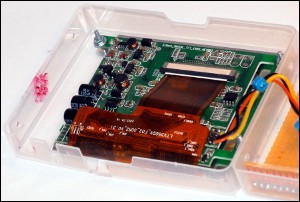 Operation
Operation
After the application has been installed, when the device is switched on, after a few seconds the LCD display should light up and display the application splash screen. This will display for a couple of seconds and then change to the home menu.
The first display line shows the current menu options.
The second display line shows the current menu name.
The third display line displays the current selected or playing item. If the item is too long it will automatically scroll to display the full item text. The first character of the item has a special meaning. '*' means the displayed item is currently playing. '.' means the displayed item is in the play-list. '>' means the displayed item is a directory.
The fourth line displays the current date and time.
There are four LEDs. The first blue LED indicates a connection to the last selected internet radio station is possible. The green LED shows that media is currently playing. The yellow LED shows the currently playing media is paused. The red LED indicates the CPU temperature is high. The second blue LED flashes to the show the system is currently operational.
Home
From the Home menu select the type of media to play, Audio, Video or Radio. The X option is to shutdown the device, connect to the Wifi network or configure the LCD sleep mode.
Video
In the Video menu, the Pause option will Pause or Resume any playing video, audio or radio station.
The Find option will display the contents of the initial video directory. Sub directories will also be displayed, so videos can be stored in logical hierarchies of directories. Only videos with extensions specified in the configuration file will be displayed. While navigating there is a left and right scroll option. A Sel option to move into a sub directory or start playing a video file. And a Back option to move back to the previous directory or back to the Video menu.
The Vol option will display the Volume menu, see below for a description of this menu.
The Back option will move back to the Home menu
Audio
In the Audio menu, the List option will display the current audio play-list. While navigating there is a left and right scroll option. A Del option to delete the currently selected item from the play-list. And a Back option to move back to the Audio menu.
The Find option will display the contents of the initial audio directory. Sub directories will also be displayed, so music can be stored in logical hierarchies of directories. Only music with extensions specified in the configuration file will be displayed. While navigating there is a left and right scroll option. A Sel option to move into a sub directory or toggle the current item into the play-list, a '.' as the first character shows the item is in the play-list. And a Back option to move back to the previous directory or back to the Audio menu.
The Vol option will display the Volume menu, see below for a description of this menu.
The Back option will move back to the Home menu
Radio
To listen to an internet radio station, a connection to the internet must be established. If the Ethernet cable is plugged in the connection should automatically be established. To use a Wifi connection, see information about the X menu below.
The Stop option will stop any playing video, audio or radio station.
The Find option will display the list of radio stations, the last one selected will automatically be selected again. While navigating there is a left and right scroll option. A Sel option to start listening to the selected internet radio station. And a Back option to move back to the Radio menu.
The Back option will move back to the Home menu
Volume
In the Volume menu, -VOL decreases the volume, +VOL increases the volume.
The Stop option will stop any playing video, audio or radio station. If no media is currently playing, this option will show as Play and will start playing the Audio play-list at the next play-list item.
The Back option will move back to the Home menu
X
In the X menu, the NET option will run the script to connect to the Wifi network.
The Sleep/Awake option will set the LCD display to be switched off after 60 seconds of inactivity or to remain on permanently.
Selecting the Yes option will shutdown the system, or selecting the No option will return to the Home menu.